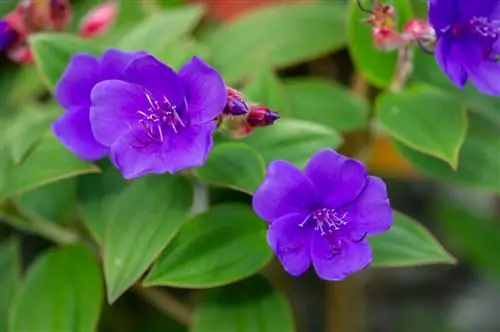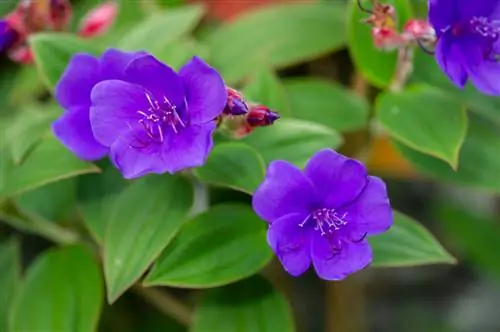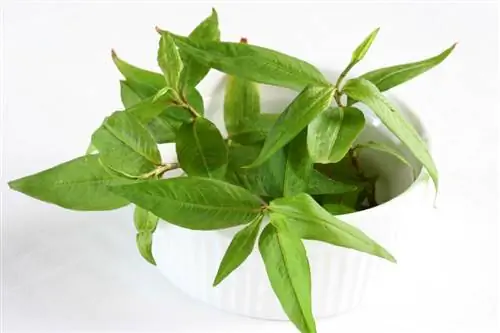- Author admin [email protected].
- Public 2023-12-16 16:46.
- Last modified 2025-06-01 06:02.
Tibouchina, as an exotic flowering beauty, is not hardy in our latitudes. The zero tolerance limit is reached long before the first frost. Timely storage in the ideal winter quarters and modified care will maneuver the princess flower safely through the cold season. This is how you overwinter Tibouchina properly.

How should you overwinter Tibouchina?
In order to overwinter Tibouchina successfully, it should be brought outside the house wall from 10° Celsius and into the cool, bright winter quarters from 5° Celsius. Water sparingly, do not fertilize and ventilate regularly. Cut back and repot at the end of February/beginning of March.
Put Tibouchina away in good time
Tibouchina (Tibouchina urveillana) goes by many names: princess flower, violet tree, samba flower or princess bush. The evergreen flowering tree with its velvety blue flowers forgives many a beginner's mistake in care. The tropical beauty from Brazil has no fun when she is expected to live in a location that is too cold. A look at the thermometer leaves no questions unanswered as to when the royal flower diva wants to go into the warmth:
- From October or 10° Celsius: change location in front of the house wall with radiating heat
- In November or from 5° Celsius: put away Tibouchina
- Short-term temperature minimum: 0° Celsius
Before putting away, clean out wilted flowers, dried out and yellow leaves. Please take this opportunity to take a close look at the undersides of the leaves. Tibouchina should not move from the balcony to its winter quarters with aphids in its luggage. Cut off any snapped, dried branches at the base.
Winter quarters: cool and with daylight
The quality of the location in winter determines the blooms next year. Frost-free, cool and bright are the ideal conditions that Tibouchina and other evergreen potted plants now want. The following overview gives the details:
- Light: bright to sunny with shading against direct winter sun
- Temperatures: ideal 10° to 15° Celsius (minimum 5° C, maximum 20° Celsius)
Glazed, unheated rooms with daylight are advantageous in several ways: optimal for flowering, effective against pests, beneficial against leaf loss. Winter gardens, glazed terraces, bright staircases, unheated guest rooms or greenhouses with frost guards find the approval of a princess flower as a winter residence. In the shady basement with temperatures around 12° Celsius, a plant lamp (€21.00 on Amazon) compensates for the lack of light when 2000 to 3000 lux affects the leaves every day.
Caring for Tibouchina in winter - tips & tricks
In connection with the autumn change of location, please stop supplying nutrients. The next time you fertilize a princess flower only at the end of the winter dormancy. On the long journey through the cold season, monthly inspection visits are a gardening must. This is how you care for a samba flower in an exemplary manner in winter:
- Water Tibouchina sparingly in rainwater or decalcified tap water
- Insert the moisture meter into the substrate in the large bucket
- Place pot on wood or insulation material to protect against cold from below
- Air regularly
- Cut back and thin out Tibouchina at the end of February/beginning of March
Always prune a violet tree in the herbaceous area. A Tibouchina no longer sprouts on old wood and does not produce flower buds there. After the shape and maintenance pruning, repot the princess flower into fresh substrate. If the first roots are sticking out of the bottom of the pot, it makes sense to move to a larger pot. Of course, more than two fingers shouldn't fit between the root ball and the vessel wall.
Tip
Grey mold (Botrytis cinerea) is a common cause when Tibouchina does not survive the winter. The problem is caused by excessive humidity in the room. Regular ventilation is an effective prevention. If the windows still fog up, set up a dehumidifier in the winter quarters. Plants with gray fungal grass should be sorted out and disposed of immediately.






